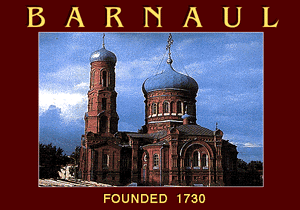|
PICTURES
Churches Modern Buildings Monuments Tsar Buildings Views
TOURS
City
Tours
HOTELS
TRANSPORT
RESTAURANTS
|
[MAIN]
[BACK] [CLOSE
WINDOW] [ADD
TO FAVOURITES]
Barnaul
 Barnaul is important industrial centre. There are
more than 100 industrial enterprises in the city with 120 thousand people
employed there. They produce diesels, metal-cutting lathes, forge presses,
steam boilers, tyres, synthetic fibres, technical carbon, boring machines,
cotton cloth, furniture, footwear, faceted diamonds.
Barnaul is important industrial centre. There are
more than 100 industrial enterprises in the city with 120 thousand people
employed there. They produce diesels, metal-cutting lathes, forge presses,
steam boilers, tyres, synthetic fibres, technical carbon, boring machines,
cotton cloth, furniture, footwear, faceted diamonds.
Barnaul is easily accessible. It is linked by air,
railways, cars and river boats with other parts of Russia and local places.
The city has five theatres, a Philharmonic
Society, three museums, twelve Palaces and Houses of Culture, ten musical
and art schools, thirty the municipal libraries with a total of 1200000
books. There is a Palace of Sports, Sport Complex "Ob", stadiums,
sportshalls, swimming pools and a hippodrome at the disposal of our
sportsmen.
Six Higher Educational Establishments of Barnaul
encompass twenty two thousand full time students majoring in fifty
specialities.
From the History of Barnaul
After Peter the Great's reforms, Russia
made a
great stride forward, rushed its way to the world arena and established
itself as an important power in Europe. It was at this time that Barnaul -
one of the oldest cities in West Siberia - emerged.
Rich copper deposits discovered at the foothills
of the Altai mountains and the construction of the first copper-smelting
works in Kolyvan preceded its appearance. Later, in 1730 the people of
Akinfy Demidov, the factory-owner from the Urals, who were busy
prospecting for a suitable site for a new and larger metal-works, selected
the one in the mouth of the Barnaulka River. This choice proved to be a
success. The place was close to water (the metal-works at that time
depended on it immensely as it put machinery into operation) and to forest
to get the necessary charcoal for copper-smelting. And though the future
work site was rather far away from the essential raw material (copper) and
its delivery was rather toilsome and costly, the choice had to be accepted
as rivers and forests in the mine vicinity were very scarce.
But copper was not the only thing that attracted
Akinfy Demidov. The explorers of the Altai foothills supposed that silver
might also be present in that area and numerous silver ornaments from the
Altai ancient barrows prompted that idea. At that time Russia did not
possess rich deposits of silver.
A thin stream of this metal flowed to the state
treasury only from the Nerchinsk factories. That is why when silver ore
was discovered in the Altai, in Zmeinaya (Snake) mountain region, the fate
of Demidov's mines and metalworks was predetermined. On May 1st, 1747,
they were taken over by the crown in a special decree of Empress Elizaveta
Petrovna to become the major silver centre of Russia.
In the 18th and early 19th centuries 90 per cent
of Russian silver - 1000 poods (16.5 tons) annually - was produced in the
Altai. The Barnaul silver-smelting works with 13 of its furnaces was
considered to be the largest one, the silver production amounted there to
450 poods (7.4 tons) a year. No wonder the small works settlement kept
growing and in 1771 it acquired the status of a mining town that was one
of the largest in Siberia. The name "mining town" was not
haphazard - all the aspects of the town's life were focused on mining
production. Russian history records only two mining towns - Ekaterinburg
and Barnaul.
The latter was not noted for its size alone. In
the 18th century it became a centre of the advanced scientific thought and
cultural life in Siberia. In 1753 a Junior Mining School attached to the
works was opened in the town.
In 1779 it was followed by a Senior Mining School
similar to the one in St. Petersburg. The
best graduates of the School could continue their education in the capital.
To meet the demands of the mining experts a unique scientific and
technological library started functioning in Barnaul in 1764. In the early
19th century the number of its books in various European languages came to
7000.
[MAIN]
[BACK] [CLOSE
WINDOW] [ADD
TO FAVOURITES]
Webmaster
[email protected]
|
 Barnaul is important industrial centre. There are
more than 100 industrial enterprises in the city with 120 thousand people
employed there. They produce diesels, metal-cutting lathes, forge presses,
steam boilers, tyres, synthetic fibres, technical carbon, boring machines,
cotton cloth, furniture, footwear, faceted diamonds.
Barnaul is important industrial centre. There are
more than 100 industrial enterprises in the city with 120 thousand people
employed there. They produce diesels, metal-cutting lathes, forge presses,
steam boilers, tyres, synthetic fibres, technical carbon, boring machines,
cotton cloth, furniture, footwear, faceted diamonds.